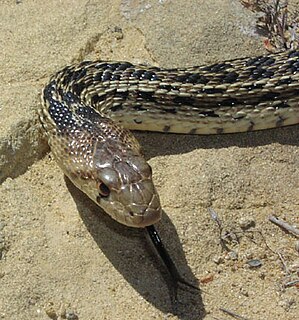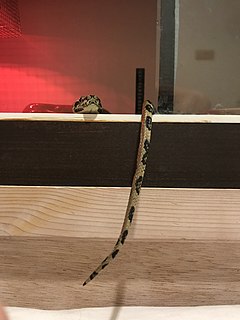Related Research Articles

Snakes are elongated, limbless, carnivorous reptiles of the suborder Serpentes. Like all other squamates, snakes are ectothermic, amniote vertebrates covered in overlapping scales. Many species of snakes have skulls with several more joints than their lizard ancestors, enabling them to swallow prey much larger than their heads with their highly mobile jaws. To accommodate their narrow bodies, snakes' paired organs appear one in front of the other instead of side by side, and most have only one functional lung. Some species retain a pelvic girdle with a pair of vestigial claws on either side of the cloaca. Lizards have evolved elongate bodies without limbs or with greatly reduced limbs about twenty-five times independently via convergent evolution, leading to many lineages of legless lizards. These resemble snakes, but several common groups of legless lizards have eyelids and external ears, which snakes lack, although this rule is not universal.

Lachesis, also known as bushmasters, is a genus of venomous pit vipers found in forested areas of Central and South America. The generic name refers to one of the Three Fates, Lachesis, in Greek mythology who determined the length of the thread of life. Four species are currently recognized.

In evolutionary biology, mimicry is an evolved resemblance between an organism and another object, often an organism of another species. Mimicry may evolve between different species, or between individuals of the same species. Often, mimicry functions to protect a species from predators, making it an anti-predator adaptation. Mimicry evolves if a receiver perceives the similarity between a mimic and a model and as a result changes its behaviour in a way that provides a selective advantage to the mimic. The resemblances that evolve in mimicry can be visual, acoustic, chemical, tactile, or electric, or combinations of these sensory modalities. Mimicry may be to the advantage of both organisms that share a resemblance, in which case it is a form of mutualism; or mimicry can be to the detriment of one, making it parasitic or competitive. The evolutionary convergence between groups is driven by the selective action of a signal-receiver or dupe. Birds, for example, use sight to identify palatable insects and butterflies, whilst avoiding the noxious ones. Over time, palatable insects may evolve to resemble noxious ones, making them mimics and the noxious ones models. In the case of mutualism, sometimes both groups are referred to as "co-mimics". It is often thought that models must be more abundant than mimics, but this is not so. Mimicry may involve numerous species; many harmless species such as hoverflies are Batesian mimics of strongly defended species such as wasps, while many such well-defended species form Müllerian mimicry rings, all resembling each other. Mimicry between prey species and their predators often involves three or more species.

The sidewinder, also known as the horned rattlesnake and sidewinder rattlesnake, is a venomous pit viper species belonging to the genus Crotalus, and is found in the desert regions of the Southwestern United States and northwestern Mexico. Three subspecies are currently recognized.

Rattlesnakes are the venomous snakes forming the genera Crotalus and Sistrurus of the subfamily Crotalinae. All rattlesnakes are vipers. The scientific name Crotalus is derived from the Greek κρόταλον, meaning "castanet". The name Sistrurus is the Latinized form of the Greek word for "tail rattler" and shares its root with the ancient Egyptian musical instrument the sistrum, a type of rattle. The 36 known species of rattlesnakes have between 65 and 70 subspecies, all native to the Americas, ranging from southern Alberta, Saskatchewan, and southern British Columbia in Canada to central Argentina. The largest rattlesnake, the eastern diamondback, can measure up to 8 ft (2.4 m) in length. Rattlesnakes are predators that live in a wide array of habitats, hunting small animals such as birds and rodents.

Belize is a country with a rich variety of wildlife, due to its unique position between North and South America, and a wide range of climates and habitats for plant and animal life. Belize's low human population, and approximately 8,867 square miles (22,970 km2) of undistributed land, provides an ideal home for more than 5000 species of plants, and vast numbers species of animals — with several hundred vertebrates including armadillos, snakes, and monkeys.

Batesian mimicry is a form of mimicry where a harmless species has evolved to imitate the warning signals of a harmful species directed at a predator of them both. It is named after the English naturalist Henry Walter Bates, after his work on butterflies in the rainforests of Brazil.

Bothrops is a genus of highly venomous pit vipers endemic to Central and South America. The generic name, Bothrops, is derived from the Greek words βόθρος, bothros, meaning "pit", and ώπς, ops, meaning "eye" or "face", together an allusion to the heat-sensitive loreal pit organs. Members of this genus are responsible for more human deaths in the Americas than any other group of venomous snakes. Currently, 45 species are recognized.

Lachesis muta, also known as the Southern American bushmaster or Atlantic bushmaster, is a venomous pit viper species found in South America, as well as the island of Trinidad in the Caribbean. Two subspecies are currently recognized, including the nominate subspecies described here.

Pituophis catenifer is a species of nonvenomous colubrid snake endemic to North America. Nine subspecies are currently recognized, including the nominotypical subspecies, Pituophis catenifer catenifer, described here. This snake is often mistaken for the prairie rattlesnake, but can be easily distinguished from a rattlesnake by the lack of black and white banding on its tail and by the shape of its head, which is narrower than a rattlesnake's.

Agkistrodon bilineatus is a highly venomous pit viper species found in Mexico and Central America as far south as Honduras.

Ambush predators or sit-and-wait predators are carnivorous animals that capture or trap prey by stealth, luring or by strategies utilizing an element of surprise. Unlike pursuit predators, who chase to capture prey using sheer speed or endurance, ambush predators avoid fatigue by staying in concealment, waiting patiently for the prey to get near, before launching a sudden overwhelming attack that quickly incapacitates and captures the prey.

Aggressive mimicry is a form of mimicry in which predators, parasites, or parasitoids share similar signals, using a harmless model, allowing them to avoid being correctly identified by their prey or host. Zoologists have repeatedly compared this strategy to a wolf in sheep's clothing. In its broadest sense, aggressive mimicry could include various types of exploitation, as when an orchid exploits a male insect by mimicking a sexually receptive female, but will here be restricted to forms of exploitation involving feeding. An alternative term Peckhamian mimicry has been suggested, but is seldom used. For example, indigenous Australians who dress up as and imitate kangaroos when hunting would not be considered aggressive mimics, nor would a human angler, though they are undoubtedly practising self-decoration camouflage. Treated separately is molecular mimicry, which shares some similarity; for instance a virus may mimic the molecular properties of its host, allowing it access to its cells.

Caudal luring is a form of aggressive mimicry characterized by the waving or wriggling of the predator's tail to attract prey. This movement attracts small animals who mistake the tail for a small worm or other small animal. When the animal approaches to prey on the worm-like tail, the predator will strike. This behavior has been recorded in snakes, sharks, and eels.

Seismic or vibrational communication is a process of conveying information through mechanical (seismic) vibrations of the substrate. The substrate may be the earth, a plant stem or leaf, the surface of a body of water, a spider's web, a honeycomb, or any of the myriad types of soil substrates. Seismic cues are generally conveyed by surface Rayleigh or bending waves generated through vibrations on the substrate, or acoustical waves that couple with the substrate. Vibrational communication is an ancient sensory modality and it is widespread in the animal kingdom where it has evolved several times independently. It has been reported in mammals, birds, reptiles, amphibians, insects, arachnids, crustaceans and nematode worms. Vibrations and other communication channels are not necessarily mutually exclusive, but can be used in multi-modal communication.

The bullsnake is a large, nonvenomous, colubrid snake. It is a subspecies of the gopher snake. The bullsnake is one of the largest/longest snakes of North America and the United States, reaching lengths up to 8 ft.

Deimatic behaviour or startle display means any pattern of bluffing behaviour in an animal that lacks strong defences, such as suddenly displaying conspicuous eyespots, to scare off or momentarily distract a predator, thus giving the prey animal an opportunity to escape. The term deimatic or dymantic originates from the Greek δειματόω (deimatόo), meaning "to frighten".

Lingual luring is a form of aggressive mimicry in which a predator uses its tongue to fool potential prey into approaching close to what appears to be a small wriggling worm.
In evolutionary biology, mimicry in vertebrates is mimicry by a vertebrate of some model, deceiving some other animal, the dupe. Mimicry differs from camouflage as it is meant to be seen, while animals use camouflage to remain hidden. Visual, olfactory, auditory, biochemical, and behavioral modalities of mimicry have been documented in vertebrates.
References
- 1 2 3 4 5 6 7 Allf, Bradley C., Paul AP Durst, and David W. Pfennig. "Behavioral Plasticity and the Origins of Novelty: The Evolution of the Rattlesnake Rattle." The American Naturalist 188.4 (2016): 475–483
- 1 2 Young, Bruce A. "Snake bioacoustics: toward a richer understanding of the behavioral ecology of snakes." The Quarterly review of biology 78.3 (2003): 303–325
- ↑ Lazell, James D. “1988. “Typhlops braminus (Brahminy Blind Snake) rattling. Herpetological Review 19.4 (1988): 85
- 1 2 3 Greene, Harry W. "Defensive tail display by snakes and amphisbaenians." Journal of Herpetology (1973): 143-161
- ↑ Mori, Akira. "Tail vibration of the Japanese grass lizard Takydromus tachydromoides as a tactic against a snake predator." Journal of Ethology 8.2 (1990): 81–88
- ↑ Martin, James H., and Roland M. Bagby. "Temperature-frequency relationship of the rattlesnake rattle." Copeia (1972): 482–485
- ↑ Allf BC, Durst PAP, Pfennig DW (2016) Data from: Behavioral plasticity and the origins of novelty: the evolution of the rattlesnake rattle. Dryad Digital Repository. https://dx.doi.org/10.5061/dryad.c36k6
- ↑ Schaeffer, P. J. K. E., K. Conley, and S. Lindstedt. "Structural correlates of speed and endurance in skeletal muscle: the rattlesnake tailshaker muscle." Journal of experimental Biology 199.2 (1996): 351–358
- ↑ Owings, Donald H., Matthew P. Rowe, and Aaron S. Rundus. "The rattling sound of rattlesnakes (Crotalus viridis) as a communicative resource for ground squirrels (Spermophilus beecheyi) and burrowing owls (Athene cunicularia)." Journal of Comparative Psychology 116.2 (2002): 197
- 1 2 Klauber, Laurence M. Rattlesnakes. Vol. 1. Univ of California Press, 1956
- ↑ Lev-Yadun, Simcha. "Does the whistling thorn acacia (Acacia drepanolobium) use auditory aposematism to deter mammalian herbivores?." Plant Signaling & Behavior 11.8 (2016): e1207035
- ↑ Williams, George Christopher. Adaptation and natural selection: a critique of some current evolutionary thought. Princeton University Press, 2008
- ↑ Allf, Bradley C., Sparkman, Amanda M., Pfennig, David W. "Microevolutionary change in mimicry? Potential erosion of rattling behaviour among nonvenomous snakes on islands lacking rattlesnakes" Ethology Ecology & Evolution (2020). DOI: 10.1080/03949370.2020.1837962
- 1 2 Moon, Brad R. "Muscle Physiology and the Evolution of the Rattling System in Rattlesnakes." Journal of Herpetology (2001): 497–500. Web
- 1 2 Schuett, Gordon W., David L. Clark, and Fred Kraus. "Feeding mimicry in the rattlesnake Sistrurus catenatus, with comments on the evolution of the rattle." Animal Behaviour 32.2 (1984): 625–626
- ↑ Tiebout, Harry M. "Caudal luring by a temperate colubrid snake, Elaphe obsoleta, and its implications for the evolution of the rattle among rattlesnakes." Journal of Herpetology 31.2 (1997): 290–292